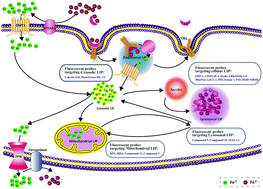The significance, trafficking and determination of labile iron in cytosol, mitochondria and lysosomes
Abstract
The labile iron pool (LIP) is a pool of chelatable and redox-active iron, not only essential for a wide variety of metabolic process, but also as a catalyst in the Fenton reaction, causing the release of hazardous reactive oxygen species (ROS) with potential for inducing oxidative stress and cell damage. The cellular LIP represents the entirety of every heterogenous sub-pool of iron, not only present in the cytosol, but also in mitochondria, lysosomes and the nucleus, which have all been detected and characterized by various fluorescent methods. Accumulated evidence indicates that alterations in the intracellular LIP can substantially contribute to a variety of injurious processes and initiate pathological development. Herein, we present our understanding of the role of the cellular LIP. To fully review the LIP, firstly, the significance of cellular labile iron in different subcellular compartments is presented. And then, the trafficking processes of cellular labile iron between/in cytosol, mitochondria and lysosomes are discussed in detail. Then, the recent progress in uncovering and assessing the cellular LIP by fluorescent methods have been noted. Overall, this summary may help to comprehensively envision the important physiological and pathological roles of the LIP and shed light on profiling the LIP in a real-time and nondestructive manner with fluorescent methods. Undoubtedly, with the advent and development of iron biology, a better understanding of iron, especially the LIP, may also enhance treatments for iron-related diseases.

- This article is part of the themed collection: Recent Review Articles


 Please wait while we load your content...
Please wait while we load your content...